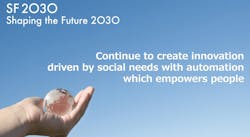The evolution of Omron Automation Americas for the past decade has been largely driven by our growth through acquisitions, which brought new technologies into the Omron portfolio. Omron is working hard to piece these key technologies together in such a way that next-generation automation solutions will not only support our customers’ business successes, but will also align with the Omron “Shape the Future 2030” (SF2030) strategy.
How will Omron apply the global strategy in the near future?
Many challenges stand in the way of reaching those long-term goals. Throughout the current period of uncertainty, the near future for manufacturers is about how to reduce backlogs and align business for growth as we stabilize supply chains by finding alternative parts and suppliers while simultaneously ensuring quality through traceability and product genealogy. How can we make production scalable? How can we use data to drive better decision-making? All of this involves following a strategic plan.
SINIC theory — short for "seed, innovation, need, impetus, cyclic evolution” — was created by Kazuma Tateishi, the founder of Omron. This theory described a never-ending cyclical relationship between societal needs and technological innovations to meet society’s demands. Following the theory, which originated in the 1970s, we are now living in what he coined an “optimization society,” where we recognize that there is an abundance of data available, which in turn presents a challenge when seeking to apply it to optimize our everyday systems and lives.
How Innovative Automation solves social challenges
The traditional way of doing manufacturing is shifting. It is more and more difficult to ensure availability of highly trained workers with experience and tenure. “Innovative Automation” is how Omron steps toward a future society where business leaders optimize their manufacturing and human productivity by leveraging more collaborative and data-driven technologies to solve business problems. Omron will focus on five industries: electric vehicles (EV), life sciences, food & commodities, electronics & semiconductors, and logistics.
Society is going through a period of talent rotation and retirement. Omron is working to empower the employees that manufacturers do have, expanding investment in collaborative robots and safety technology. Safe deployment of automation in a human environment makes it easier to adopt, driving an increase in overall labor efficiency. Omron is not only making the technology easier to adopt, but also is offering training service to enhance workers’ skills.
How Omron can help achieve flexibility in production
Customers have numerous options, but it can often be difficult to get multiple automation vendors working together. In the mobile robot space, near-future investments are enabling a mixed-fleet type of technology. As standards mature, the critical question for manufacturers is how to get the most out of automated guided vehicles (AGVs) and autonomous mobile robots (AMRs), as well as how to transfer any currently learned robot control models to future robots without retraining.
Most manufacturers are familiar with using artificial intelligence (AI) for vision inspection on previously unseen defects. “We’re also applying that AI to our customers’ assets across the entire process,” explained Chen. Omron is researching technology that can help customers identify and contextualize anomalies upstream and downstream in their production process, not only within a single production cell. This way, human workers can reduce their time to respond to incidents, or even to go further into creating automated system correction.
Manufacturers implementing automation must always consider how to maximize that return on investment (ROI). Now, as societal consumer demands shift more rapidly and force smaller batch sizes or production runs, manufacturers can improve their ROI if their automation systems are more flexible. Omron is offering cost-effective and re-deployable automation to meet customer demand for shorter production runs and/or higher-mix, low-volume parts.
Digitalization of engineering workflow and the use of advanced simulation can help manufacturers de-risk automation investments and improve deployment time. Omron is actively investigating how it goes beyond virtual commissioning. The digital twin simulation would then use ongoing monitoring data in real time so that manufacturers can look for longer-term potential maintenance issues.
Omron has a commitment to sustainability and reducing its environmental impact. As such, Omron is looking to partner with customers working to reduce society’s environmental impact, with one example being battery manufacturing in place of traditional carbon fuels. “We’re developing different ways to use our motion-control capabilities to reduce waste and misalignment with laminated and solid-state batteries,” said Chen. “And in the very near future, there are a lot of batteries that will need to be recycled. We’re researching the battery labeling standards so that our code reading and vision products can help recycle those batteries more efficiently.”


